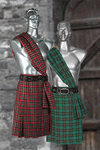Medieval Kilts Have Their Roots as Warfare Garments
Now considered to be the national dress of the country of Scotland, Medieval Kilts were originally worn by Scottish Highlanders who wanted the ability to move freely about in battle. No documentation of the existence of this garment occurs before 1575. The first recorded instance of kilts being worn as a military garment appeared in 1594 in “The Life of Red Hugh O’Donnell.”
Medieval kilts also provided warmth. Made of tightly woven wool, kilts created a barrier between rain and the skin. Pleats afforded a minor form of protection similar to armor. Because the garment could be easily removed, soldiers often used them like a blanket, spreading their kilts upon the ground at night.
Originally kilts were referred to as the feileadh mhór (philamore), or the big wrap. Top and bottom portions were separate with the top detachable and worn over the shoulder for comfort. Initially the garment’s apron was also left unattached while worn. Early versions also did not have the tartans that characterize contemporary kilts.
Today’s kilts have tartans denoting the Scottish clan of which the wearer is a member. These garments are also much shorter than those worn in the past and are often used for ceremonial occasions.
